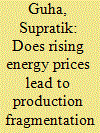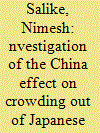| Srl | Item |
| 1 |
ID:
190834


|
|
|
|
|
| Summary/Abstract |
How does the price of energy affect the extent of production fragmentation in India’s manufacturing industries? The prevailing literature has engaged with production fragmentation and trade in middle products for a long time, but the relationship between energy prices and production fragmentation is less understood. This article deals with firm-level panel data of India’s manufacturing industries between 2005 and 2018 to estimate the impact of rising energy prices on the outsourcing decisions/production organization of the manufacturing firms. The article also uses a number of covariates, including wages, welfare expenses, sales, profit after tax, dividend rate, foreign exchange earnings and an interaction term between energy prices and foreign exchange earnings. The empirical results of this article indicate that larger firms tend to outsource production in part to smaller firms in order to cope with rising energy prices and keep their profitability intact. Static and dynamic panel estimates with a variety of robustness analyses support the main conjectures.
|
|
|
|
|
|
|
|
|
|
|
|
|
|
|
|
| 2 |
ID:
101159


|
|
|
|
|
| Publication |
2010.
|
| Summary/Abstract |
This paper applies a dynamic panel model to investigate whether China is crowding out Japanese foreign direct investment (FDI) from other economies of Asia. We examined this with industry-level data on Japanese FDI flows into Asian economies. In order to deal with possible problems of serial correlation and endogeneity, we estimated coefficients using a difference and system generalized method of moments to examine the "China effect" on industries. We found a significantly high degree of crowding out effect by China on its Asian counterparts. Among twelve industries, a crowding out effect was found in nine industries, including electrical & electronics-the biggest industry for Japanese FDI. However, a complementary effect was found in two industries, one of them being transport, which is the second biggest industry for Japanese FDI. We conclude that while China's rise is a prominent threat for the region, it could be transformed into an opportunity in vertically fragmented industries.
|
|
|
|
|
|
|
|
|
|
|
|
|
|
|
|